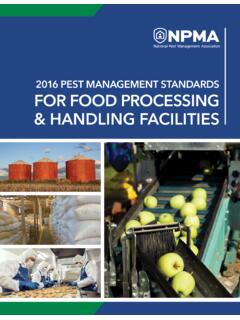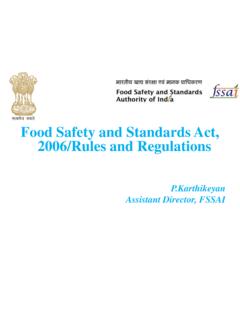Transcription of Food Fraud and 'Economically Motivated Adulteration' of ...
1 food Fraud and economically Motivated adulteration of food and food Ingredients Ren e Johnson Specialist in Agricultural Policy January 10, 2014 Congressional Research Service 7-5700 R43358 food Fraud and economically Motivated adulteration of food and food Ingredients Congressional Research Service Summary food Fraud , or the act of defrauding buyers of food or ingredients for economic gain whether they be consumers or food manufacturers, retailers, and importers has vexed the food industry throughout history. Some of the earliest reported cases of food Fraud , dating back thousands of years, involved olive oil, tea, wine, and spices. These products continue to be associated with Fraud , along with some other foods. Although the vast majority of Fraud incidents do not pose a public health risk, some cases have resulted in actual or potential public health risks. Perhaps the most high-profile case has involved the addition of melamine to high-protein feed and milk-based products to artificially inflate protein values in products that may have been diluted.
2 In 2007, pet food adulterated with melamine reportedly killed a large number of dogs and cats in the United States, followed by reports that melamine-contaminated baby formula had sickened thousands of Chinese children. Fraud was also a motive behind Peanut Corporation of America s actions in connection with the Salmonella outbreak in 2009, which killed 9 people and sickened 700. Reports also indicate that fish and seafood Fraud is widespread, consisting mostly of a lower-valued species, which may be associated with some types of food poisoning or allergens, mislabeled as a higher-value species. Other types of foods associated with Fraud include honey, meat and grain-based foods, fruit juices, organic foods, coffee, and some highly processed foods. It is not known conclusively how widespread food Fraud is in the United States or worldwide. In part, this is because those who commit food Fraud want to avoid detection and do not necessarily intend to cause physical harm.
3 Most incidents go undetected since they usually do not result in a food safety risk and consumers often do not notice a quality problem. Although the full scale of food Fraud is not known, the number of documented incidents may be a small fraction of the true number of incidents. The Grocery Manufacturers Association estimates that Fraud may cost the global food industry between $10 billion and $15 billion per year, affecting approximately 10% of all commercially sold food products. Fraud resulting in a food safety or public health risk event could have significant financial or public relations consequences for a food industry or company. There is no statutory definition of food Fraud or economically Motivated adulteration (EMA) of foods or food ingredients in the United States. However, as part of a 2009 public meeting, the food and Drug Administration (FDA) adopted a working definition, defining EMA as the fraudulent, intentional substitution or addition of a substance in a product for the purpose of increasing the apparent value of the product or reducing the cost of its production, , for economic gain.
4 Efforts are ongoing to compile and capture current and historical data on food Fraud and EMA incidents through the creation of databases and repositories. Over the years, Congress has introduced a number of bills intended to address concerns about food Fraud for a particular food or food ingredient. Such legislation has not addressed food Fraud in a comprehensive manner. However, although no single federal agency or law directly addresses food Fraud , a number of existing laws and statutes already provide the authority for various federal agencies to address Fraud . Currently, food Fraud is broadly addressed through various food safety, food defense, and food quality authorities as well as border protection and import authorities across a number of federal agencies. FDA and the Department of Agriculture are the principle agencies that are working to protect the food supply from food safety risks both unintentionally and intentionally introduced contamination in conjunction with border protection and enforcement activities by the Department of Homeland Security.
5 Other agencies also play a role. food Fraud and economically Motivated adulteration of food and food Ingredients Congressional Research Service food Fraud and economically Motivated adulteration of food and food Ingredients Congressional Research Service Contents Background .. 1 Existing Definitions .. 5 Risks to food Protection .. 7 Available Data and Information Repositories .. 10 Review of Available Database Information .. 10 USP food Fraud Database .. 11 NCFPD EMA Incident Database .. 12 Leading Reported Types of Fraud .. 13 USP food Fraud Database .. 14 NCFPD EMA Incident Database .. 17 Differences in Product Ranking among Databases .. 20 Federal Activities Involving food Fraud .. 22 HHS, food and Drug Administration .. 24 food Safety Authorities .. 24 Potential Role of the food Safety Modernization Act .. 28 Import Authorities .. 30 USDA, food Safety and Inspection Service.
6 32 food Safety Authorities .. 32 Import Authorities .. 35 DHS, Customs and Border Protection .. 35 Other Federal food Quality or food Safety Programs .. 36 USDA, Agricultural Marketing Service .. 37 NOAA, National Marine Fisheries Service .. 38 Congressional Actions Involving food Fraud .. 39 Figures Figure 1. food Protection Risk Matrix .. 9 Figure 2. Leading Reported Types of Fraud , USP Scholarly Records (1980-2010) .. 15 Figure 3. Leading Reported Types of Fraud , USP Media Records (1980-2010) .. 15 Figure 4. Leading Reported Types of Fraud , USP Scholarly Records (1980-2012) .. 16 Figure 5. Leading EMA Incidents by food Ingredient Category (1980 to date) .. 18 Figure 6. Leading EMA Incidents by Type of adulteration (1980 to date) .. 19 Figure 7. Leading EMA Incidents by Location Produced (1980 to date) .. 20 Ta b l e s Table 1. food Protection Risk: Examples, Cause and Effects.
7 9 Table 2. Scope of USP food Fraud Database .. 14 Table 3. Leading Reported Types of food Fraud , Differing Compilations .. 21 food Fraud and economically Motivated adulteration of food and food Ingredients Congressional Research Service Table 4. Registered food Facilities, FY2004-FY2012 .. 27 Contacts Author Contact 40 food Fraud and economically Motivated adulteration of food and food Ingredients Congressional Research Service 1 Background food Fraud , or the act of defrauding buyers of food and food ingredients for economic gain whether they be consumers or food manufacturers, retailers, and importers has vexed the food industry throughout history. Some of the earliest reported cases of food Fraud , dating back thousands of years, involved olive oil, wine, spices, and These same products continue to be associated with Fraud , along with a range of other products.
8 Overall, foods and food ingredients commonly associated with food Fraud include olive oil, fish, honey, milk and dairy products, meat products, grain-based foods, fruit juices, wine and alcoholic beverages, organic foods, spices, coffee, and tea, and some highly processed foods. It is not known conclusively how widespread food Fraud is in the United States or worldwide. In part, this is because those who commit Fraud do not intend to cause physical harm and want to avoid detection. Most incidents go undetected since they usually do not result in a food safety risk and consumers often do not notice a quality problem. Moreover, as the motivation to commit Fraud is illicit monetary gain, the type of food that might be or become adulterated is a secondary consideration ( , it could be any type of food or food ingredient); rather, it is the opportunity or feasibility of committing Fraud that generally triggers the Although the vast majority of food Fraud incidents do not pose a public health risk, there have been Fraud cases that have resulted in actual or potential public health risks.
9 Perhaps the most widely cited, high-profile cases have involved the addition of melamine to high-protein feed and milk-based products to artificially inflate protein values in products that may have been diluted. For example, in 2007, evidence emerged that adulterated pet food ingredients from China had caused the deaths of a large number of dogs and cats in the United This was followed by reports that melamine-contaminated baby formula had sickened an estimated 300,000 Chinese children, killing a reported 6 Evidence now suggests that safety risks associated with melamine-tainted feed date back to 2003, and that melamine was first reported to be added to artificially increase protein content in feed as far back as Reports also indicate fish and seafood Fraud may be widespread in some markets, consisting mostly of the mislabeling or substitution of a higher-valued species with something different from and inferior to the expected species, possibly with a fish species which could be associated with some types of food poisoning or exposure to certain Similarly.
10 Substitution of olive oil with other types of seed, legume, or nut oils could have unintended consequences, if consumed by those with certain food allergies. 1 See, for example, B. Wilson, Swindled: From Poison Sweets to Counterfeit Coffee The Dark History of food Fraud , John Murray (Publishers), 2008; T. Mueller, Extra Virginity: The Sublime and Scandalous World of Olive Oil, W. W. Norton & Company, 2011; and S. Foster, A Brief History of adulteration of Herbs, Spices, and Botanical Drugs, HerbalGram, Issue 92 (pp. 42-57), 2011, American Botanical Council. 2 CRS communication with researchers at the United States Pharmacopeial Convention (USP), December 23, 2013. 3 For other background information, see CRS Report RL34080, food and Agricultural Imports from China. 4 H. Bottemiller, Chinese Authorities Seize Melamine-tainted Dairy, food Safety News, April 29, 2011.












